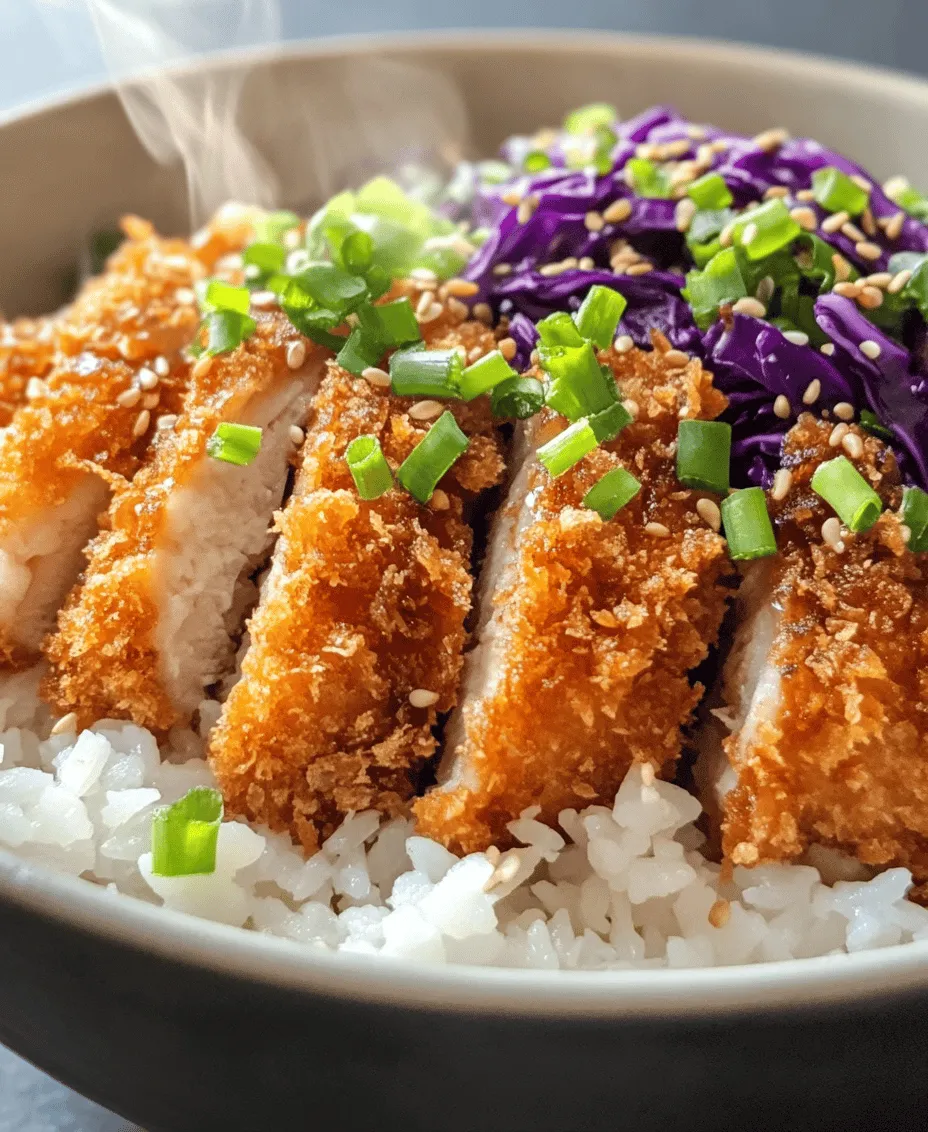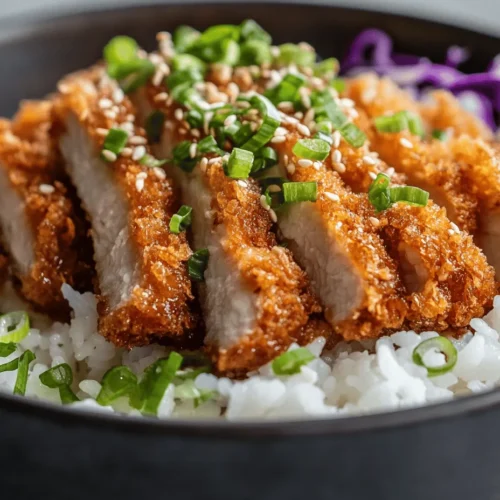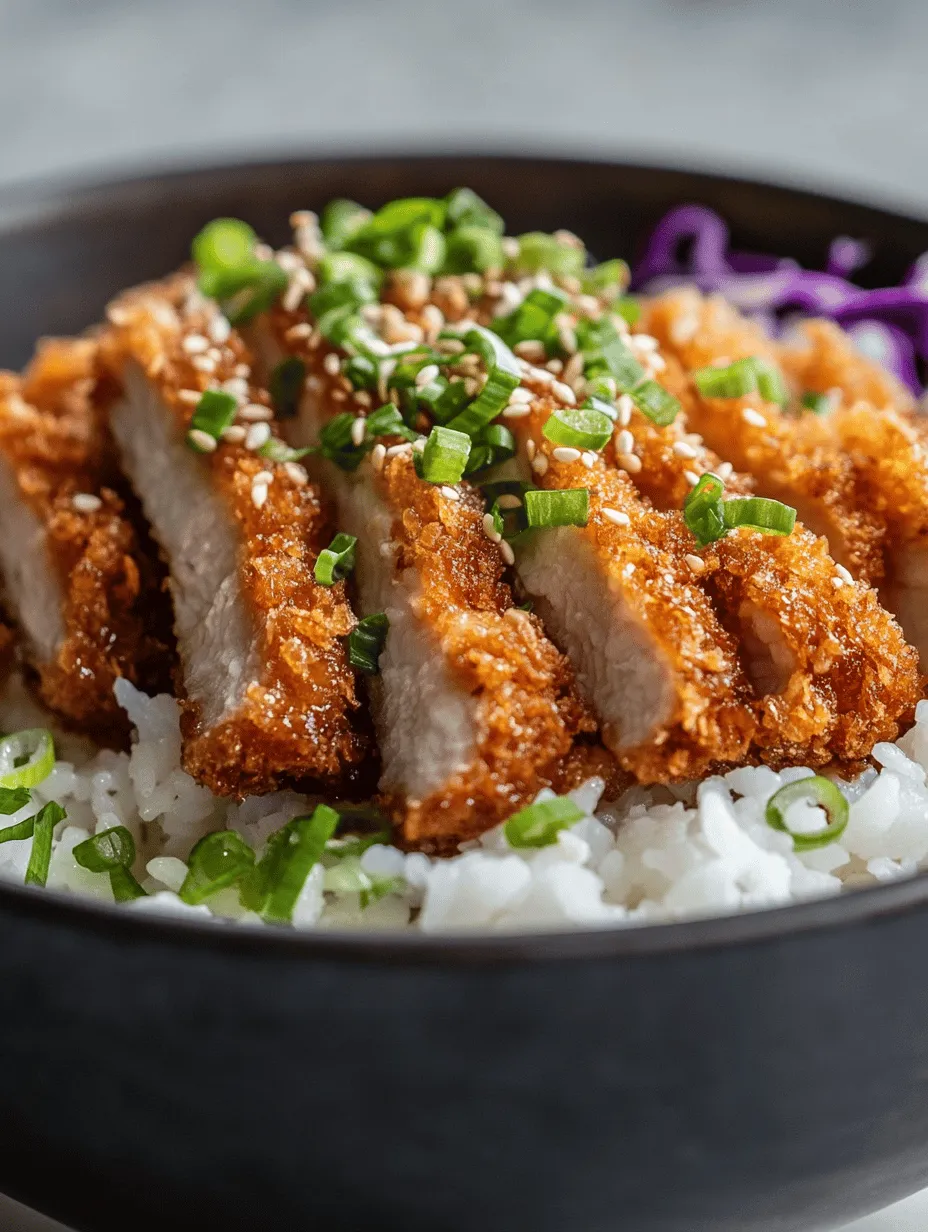Introduction
Welcome to the delightful world of Japanese cuisine, where each dish tells a story and tantalizes the senses. Among the many culinary treasures of Japan, the Katsu Bowl stands out as a beloved comfort food that perfectly marries crispy, golden pork cutlets with fluffy rice and vibrant garnishes. This dish is not just a meal; it’s an experience steeped in tradition and flavor, making it a favorite among food enthusiasts both in Japan and around the globe.
The Katsu Bowl is a beautiful representation of harmony in flavors and textures. The tender, juicy pork cutlet, often made from pork loin, contrasts beautifully with the crunchy exterior created by panko breadcrumbs. The accompanying rice, cooked to perfection, serves as a comforting base, while the garnishes—like shredded cabbage and finely chopped green onions—add freshness and visual appeal. The pièce de résistance? A homemade Tonkatsu sauce that elevates this dish to extraordinary heights, imparting a rich, savory sweetness that ties everything together.
In this article, we will explore what makes the Katsu Bowl special, delve into its cultural significance, and guide you through the steps to create your own delightful version at home. Whether you are a seasoned chef or a culinary novice, this recipe will lead you through the process of crafting a dish that is both satisfying and impressive.
Understanding Katsu Bowls
To truly appreciate the Katsu Bowl, we must explore its origins and significance within Japanese culinary traditions. The term “Katsu” derives from the Japanese word “katsudō,” which means to cut or to win. This dish is believed to have evolved from the European dish “cutlet,” introduced to Japan in the late 19th century. The adaptation of this dish into what is now known as Tonkatsu—a breaded and deep-fried pork cutlet—reflects Japan’s ability to integrate foreign influences into its rich culinary landscape.
Tonkatsu has become a staple in Japanese cuisine, often served with shredded cabbage, rice, and miso soup. The evolution of Katsu from its original European form to the Japanese classic we know today demonstrates a fascinating cultural exchange that has resulted in a dish that is uniquely Japanese. The Tonkatsu sauce, an essential component of the Katsu Bowl, further enhances this dish. This sauce is a concoction of various ingredients that provides a perfect balance of sweetness and umami, making it a delightful accompaniment to the crispy pork.
The Katsu Bowl is more than just a meal; it encapsulates a rich history and cultural significance that reflects Japan’s culinary journey. As you prepare to create this dish, remember that you are not just cooking; you are participating in a tradition that has been cherished for generations.
Ingredients Overview
Now that we have set the stage, let’s dive into the key ingredients that make up the Katsu Bowl. Each component plays a crucial role in achieving the perfect balance of flavors and textures that this dish is known for.
1. Pork Loin Chops: Choosing the right cut of meat is essential for a successful Katsu Bowl. Pork loin chops are ideal due to their tenderness and mild flavor. They have just the right amount of fat to keep the cutlets juicy during frying, while still being lean enough for a satisfying bite. When selecting your pork, look for cuts that are at least one inch thick to ensure they remain tender and juicy after cooking.
2. Panko Breadcrumbs: The secret to achieving that perfect crunch lies in the use of panko breadcrumbs. Unlike traditional breadcrumbs, panko is lighter and airier, which allows for a crispier texture when fried. This Japanese-style breadcrumb is made from white bread without crusts and is coarsely ground, giving it a distinctive texture that holds up well during cooking. The result is a delectably crispy coating that contrasts beautifully with the moist pork.
3. Japanese Short-Grain Rice: Authenticity is key when it comes to Japanese cuisine, and using the right type of rice is paramount. Japanese short-grain rice is known for its sticky texture and slightly sweet flavor, making it the perfect base for the Katsu Bowl. When cooked, this rice clumps together, allowing you to easily scoop it up with chopsticks, enhancing the overall dining experience.
4. Garnishes: A Katsu Bowl is not complete without its colorful and flavorful garnishes. Shredded cabbage adds a refreshing crunch and a hint of bitterness that balances the richness of the pork. Green onions provide a burst of freshness and a mild onion flavor, while a sprinkle of sesame seeds adds a nutty aroma and visual appeal. These garnishes not only enhance the flavor profile of the dish but also contribute to its presentation, making your Katsu Bowl a feast for the eyes as well as the palate.
Preparation of Tonkatsu Sauce
No Katsu Bowl would be complete without its signature Tonkatsu sauce. This homemade condiment is a delightful blend of flavors that elevates the dish and adds depth to every bite. Making your own Tonkatsu sauce is not only simple but also allows you to customize the taste to your liking.
The base of the sauce typically includes ketchup, which adds sweetness, and Worcestershire sauce, which contributes a complex umami flavor. The combination of these two ingredients creates a rich and tangy profile that complements the crispy pork beautifully. Adding sugar enhances the sweetness, while soy sauce introduces a savory depth that rounds out the flavor.
To add a layer of complexity, ingredients such as mirin—a sweet rice wine—and Dijon mustard are often included. Mirin brings a touch of sweetness and a slight alcoholic note, while Dijon mustard adds a hint of spiciness and sharpness. The balance of these ingredients is key to achieving that signature Tonkatsu sauce flavor.
As you prepare the sauce, feel free to taste and adjust the ingredients according to your preference. Some may prefer a sweeter sauce, while others may enjoy a more savory profile. This versatility makes the Tonkatsu sauce a valuable addition to your culinary repertoire, as it can be used in various dishes beyond the Katsu Bowl.
Step-by-Step Guide to Preparing Katsu Bowl
Now that you have a solid understanding of the Katsu Bowl’s components, it’s time to dive into the step-by-step process of preparing this flavorful dish. In the following sections, we will guide you through each stage, ensuring you feel confident and excited to recreate this Japanese delight in your own kitchen.
Stay tuned as we explore the detailed instructions on how to bread and fry the pork cutlets, cook the rice to perfection, and assemble your Katsu Bowl into a beautiful and delicious presentation. Each step is designed to bring you closer to mastering this iconic dish, filling your home with the irresistible aromas of Japan.

Preparing the Pork
When it comes to creating a delicious Katsu Bowl, the quality of the pork is paramount. Start with a good cut of pork loin or pork tenderloin, as these cuts are tender and well-suited for frying. The first step is to prepare the pork properly; this means not only slicing it to an appropriate thickness but also seasoning it effectively.
To ensure that the flavors penetrate the meat, lightly pound the pork cutlets to about half an inch thick. This tenderizes the meat and helps it cook evenly. After pounding, season both sides generously with salt and black pepper. Seasoning is crucial—it enhances the natural flavors of the pork and ensures that every bite is flavorful. Allow the seasoned pork to rest for about 10-15 minutes, letting the salt work its magic and draw out moisture, which will enhance the texture and taste of the pork.
Breading the Pork
The breading process is where the Katsu Bowl truly comes to life with its signature crispy texture. Create a three-step breading station: one bowl with flour, a second with beaten eggs, and a third with panko breadcrumbs.
1. Flour: Begin by dredging each piece of seasoned pork in flour, shaking off any excess. The flour helps the egg adhere to the meat.
2. Egg: Next, dip the flour-coated pork into the beaten eggs, ensuring it is well-covered. The egg acts as a glue that binds the panko breadcrumbs to the pork.
3. Panko: Finally, coat the pork with panko breadcrumbs, pressing gently to ensure an even coverage. Panko is key to achieving that light, crispy texture we all love in Katsu; it absorbs less oil than regular breadcrumbs and creates a delightful crunch.
Once your pork is breaded, set it aside on a wire rack or a plate while you prepare to cook. This resting period allows the breading to adhere more firmly, reducing the chances of it falling off during frying.
Cooking the Pork
Now, it’s time to fry the breaded pork to golden perfection. Heat a generous amount of oil in a deep skillet or frying pan over medium-high heat. The oil should be hot enough that a few breadcrumbs dropped into it sizzle immediately, but not so hot that they burn. An ideal frying temperature is between 350°F to 375°F (175°C to 190°C). Using a kitchen thermometer can help you monitor the temperature accurately.
Carefully place the breaded pork cutlets into the hot oil, ensuring not to overcrowd the pan, as this can lower the oil temperature and lead to greasy pork. Fry each cutlet for about 3-4 minutes on each side, or until they reach a deep golden brown color. Use tongs to gently flip the pork, making sure to avoid splashing hot oil.
Once cooked, transfer the Katsu to a plate lined with paper towels to drain excess oil. This step is crucial as it ensures your cutlets remain crispy and not soggy. Allow them to rest for a few minutes before slicing, which helps keep the juices locked in.
Assembling the Katsu Bowl
Assembling your Katsu Bowl is where you can let your creativity shine. Start with a base of perfectly cooked rice—Japanese short-grain rice is ideal for its sticky texture, which holds the bowl together. Place a generous scoop of rice in the center of the bowl.
Next, slice the crispy Katsu into strips and arrange them artistically over the rice. The presentation is important; a well-arranged bowl is visually appealing and enhances the dining experience. Add a side of shredded cabbage, which adds a crunchy contrast to the richness of the Katsu. You can also include additional toppings such as sliced green onions, a sprinkle of sesame seeds, or a drizzle of tonkatsu sauce to elevate the dish further.
For those who enjoy a little heat, consider adding a few slices of fresh chili or a sprinkle of shichimi togarashi (Japanese seven-spice blend) for an extra kick.
Serving Suggestions
The Katsu Bowl is fantastic on its own, but it can be elevated with the right accompaniments. Traditional side dishes that pair beautifully with Katsu include miso soup and pickled vegetables, which provide a refreshing contrast to the richness of the pork.
For a lighter option, consider serving the Katsu Bowl with a side of edamame or a simple cucumber salad dressed with rice vinegar. If you’re catering to different dietary preferences, feel free to swap the pork for chicken or tofu, maintaining the same breading and cooking techniques for a delightful vegetarian or poultry version.
Additionally, experimenting with different sauces can add a unique twist. Try serving the Katsu with a spicy mayo or a homemade ponzu sauce for a zesty flavor profile.
Nutritional Information
Understanding the nutritional content of your Katsu Bowl can help you make informed choices. A typical serving of Katsu Bowl with pork, rice, and cabbage may contain approximately 600-800 calories, depending on portion sizes and added ingredients. The macronutrient breakdown generally includes:
– Protein: The pork provides a significant amount of protein, essential for muscle repair and growth.
– Carbohydrates: The rice serves as a source of energy, particularly beneficial for active individuals.
– Fats: Frying in oil increases the fat content, so be mindful of the amount of oil used.
For a healthier alternative, consider using air-fried Katsu or baked versions to reduce the calorie count. You can also substitute white rice with brown rice or cauliflower rice for a more nutritious base.
Cultural Significance and Variations of Katsu
Katsu has a rich cultural history in Japan, often associated with comfort food. It is believed that the dish was inspired by European breaded cutlets and has since evolved into a beloved staple in Japanese cuisine. Across Japan, you will find various regional adaptations of Katsu, each with unique twists in preparation and presentation. For instance, in some regions, Katsu is served with a savory curry sauce, while others may offer a cheesy version known as “cheese Katsu.”
Moreover, the Katsu Bowl has seen its share of adaptations, particularly with the rise of vegetarian and vegan diets. Options such as eggplant Katsu or mushroom Katsu are becoming increasingly popular, allowing more people to enjoy this delightful dish.
Conclusion
Creating a Katsu Bowl is not just about making a meal; it is about embracing a comforting and flavorful part of Japanese cuisine. With its crispy pork, fluffy rice, and vibrant accompaniments, each bowl tells a story of culinary tradition and creativity. As you experiment with the recipe, don’t hesitate to personalize it to fit your tastes or dietary needs.
Remember, sharing meals is at the heart of culinary experiences. Whether enjoyed solo or with friends and family, the Katsu Bowl brings people together, creating lasting memories around the dinner table. So gather your ingredients, follow the steps, and indulge in the bliss of a homemade Katsu Bowl that is sure to be a hit!


